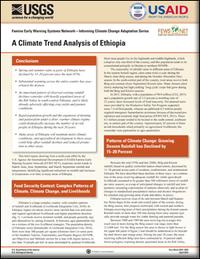This brief report, drawing from a multi-year effort by the U.S. Agency for International Development (USAID) Famine Early Warning Systems Network (FEWS NET), examines recent trends in March-June, June-September, and March-September rainfall and temperature, identifying significant reductions in rainfall and increases in temperature over time in many areas of Ethiopia. Conclusions: * Spring and summer rains in parts of Ethiopia have declined by 15-20 percent since the mid-1970s. * Substantial warming across the entire country has exacerbated the dryness.* An important pattern of observed existing rainfall declines coincides with heavily populated areas of the Rift Valley in south-central Ethiopia, and is likely already adversely affecting crop yields and pasture conditions. * Rapid population growth and the expansion of farming and pastoralism under a drier, warmer climate regime could dramatically increase the number of at-risk people in Ethiopia during the next 20 years.* Many areas of Ethiopia will maintain moist climate conditions, and agricultural development in these areas could help offset rainfall declines and reduced production in other areas.


